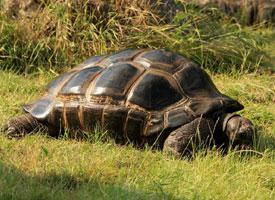
Állatleírás
The Galápagos tortoise (Geochelone nigra complex), also known as the giant Galápagos tortoise, is an iconic species endemic to the Galápagos Islands. This magnificent creature is the largest living species of tortoise in the world, with some individuals reaching over 4 feet (1.2 meters) in length and weighing more than 500 pounds (227 kilograms). The Galápagos tortoise is not just one species but a complex of several species and subspecies, each adapted to life on different islands or parts of islands within the Galápagos archipelago. This diversity is a stunning example of adaptive radiation, where a single ancestral species evolves into multiple species or subspecies, each with unique adaptations to their specific environments.The physical appearance of the Galápagos tortoise varies significantly among the different species and subspecies, reflecting their adaptation to different ecological niches. Some have domed shells, while others have saddleback shells, which are elevated at the front, allowing the tortoise to extend its neck higher to reach vegetation. The color of their skin and shell ranges from dark black to brown. Despite these differences, all share the common feature of powerful, sturdy legs that support their massive bodies, and their iconic slow movement.
Galápagos tortoises are herbivores, feeding primarily on grasses, leaves, cactus pads, and fruits. Their diet varies with the season and the island they inhabit. These tortoises play a crucial role in their ecosystem, acting as "ecosystem engineers." They disperse seeds and create open areas in vegetation that allow other plant species to grow.
These tortoises have a remarkably slow metabolism and can survive without food or water for up to a year. This adaptation likely evolved as a response to the harsh conditions of their island habitats, where food and water can be scarce for extended periods.
Galápagos tortoises have a very long lifespan, with many individuals living over 100 years. This longevity, combined with their late sexual maturity, makes their populations vulnerable to over-exploitation and habitat destruction. Historically, they were hunted for their meat and oil by sailors and pirates, which, along with the introduction of non-native species to the islands, led to a dramatic decline in their numbers.
Today, the Galápagos tortoise is considered vulnerable or endangered, depending on the specific species or subspecies. Conservation efforts are underway to protect these ancient animals, including habitat restoration, eradication of invasive species, and breeding programs aimed at increasing their population numbers. The Charles Darwin Research Station on the Galápagos Islands plays a pivotal role in these conservation efforts, successfully breeding and releasing tortoises back into the wild.
The Galápagos tortoise is not only a symbol of the Galápagos Islands but also a testament to the power of evolution and natural selection. These gentle giants have captured the imagination of scientists, conservationists, and the public alike, highlighting the importance of preserving the unique biodiversity of our planet.
Hasonló állatok
Új állatfotók
Top 10 állat
- Dolphin gull (Leucophaeus scoresbii)
- Diana monkey (Cercopithecus diana)
- Moustached guenon (Cercopithecus cephus)
- Galápagos tortoise (Geochelone nigra complex)
- Japanese macaque (Macaca fuscata)
- Stone loach (Barbatula barbatula)
- Russian tortoise (Testudo horsfieldii)
- Greek tortoise (Testudo graeca)
- Common flying dragon (Draco volans)
- Vendace (Coregonus albula)


